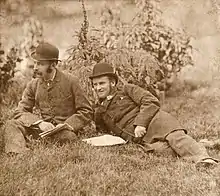John Haynes (journalist)
John Haynes (26 April 1850 – 15 August 1917) was a parliamentarian in New South Wales, Australia for five months short of thirty years, and co-founder (1880), with J. F. Archibald, of The Bulletin.

Life and career
Haynes was born in Singleton, New South Wales, son of John Haynes, a schoolteacher, and his wife Margaret, née Daly. He was apprenticed as a compositor with the Morpeth Leader and worked for several country newspapers. In 1871, he married Sarah Belford and they had five sons and one daughter. In 1873, he moved to Sydney.[1][2] In 1880, he founded The Bulletin with Archibald, and in 18 months built its circulation in up to 15,000. He believed in serious provocative journalism, especially exposure articles. As the result of one article, he was sued by the owner of the Clontarf pleasure gardens. He refused to pay the costs of the resulting libel action and was imprisoned for six weeks in 1882[2] (the public raised £3,000 and he was released).
In 1887, Haynes stood for Mudgee, as a supporter of the Free Trade Party, led by Henry Parkes, which tended to be associated with Protestants. During the campaign, he repudiated his Roman Catholic faith, which led to lasting bitterness with Protectionists. He was elected and held Mudgee to 1894.[1]
In 1891, Haynes was ratepayer on several Sydney addresses that were the focus of radical and even anarchist activity in Sydney (Leigh House, Active Service Brigade HQ and William McNamara's Book Depot). He married his second wife, Mary Duff, in 1892 and was elected as member for Wellington in 1894.[1] He continued to support free trade and decentralisation. He was an unruly member of Parliament and his constant accusation of corruption involved him in bitter arguments and physical aggression, including an attack on the Protectionist member William Patrick Crick in 1893. He married his third wife, Esther Campbell, in 1899 and they had one daughter and one son. In 1904, he was narrowly defeated for Wellington, and continued to lose elections until elected to Willoughby in 1915, but he was defeated in 1917.[2]
Haynes continued to pursue the allegedly corrupt politicians Crick and William Nicholas Willis through the courts, the latter all the way to South Africa. The 1906 Royal Commission on Lands Administration partly supported his allegations.[2] He was later editor of the Newsletter, which in 1906 attacked John Norton, fellow parliamentarian and Truth publisher, as a criminal and murderer.
Death
Haynes died at his residence at Alfred Street, North Sydney from heart failure supervening Influenza.[3] He was buried on 17 August 1917 in the Presbyterian section of Rookwood Cemetery.[4]
Notes
- "Mr John Haynes (1850–1917)". Former Members of the Parliament of New South Wales. Retrieved 11 May 2019.
- Radi, Heather. "Haynes, John (1850–1917)". Australian Dictionary of Biography. Australian National University. Retrieved 15 February 2007.
- Sydney Morning Herald. Death of Mr. John Haynes. 16 August 1917, Article, page 8
- Sydney Morning Herald. John Haynes. (ex M.L.A.)- FUNERAL NOTICE. – 17 August 1917, page 5.
| New South Wales Legislative Assembly | ||
|---|---|---|
| Preceded by Adolphus Taylor |
Member for Mudgee 1887–1894 Served alongside: Black/Jones, Wall |
Succeeded by Robert Jones |
| Preceded by Thomas York |
Member for Wellington 1894–1904 |
Succeeded by Abolished |
| Preceded by Edward Larkin |
Member for Willoughby 1915–1917 |
Succeeded by Reginald Weaver |